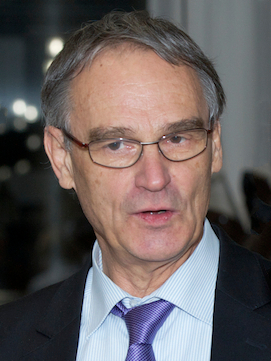Gerd Binnig facts for kids
Quick facts for kids
Gerd Binnig
|
|
|---|---|

Binnig in 2013
|
|
| Born | 20 July 1947 |
| Alma mater | Goethe University Frankfurt |
| Known for | Scanning tunneling microscope Scanning probe microscopy Atomic force microscope |
| Awards | Klung Wilhelmy Science Award (1983) EPS Europhysics Prize (1984) King Faisal Prize (1984) Nobel Prize in Physics (1986) The Elliott Cresson Medal (1987) Kavli Prize (2016) |
| Scientific career | |
| Fields | Physics |
| Institutions | IBM Zurich Research Laboratory |
| Doctoral advisor | Werner Martienssen Eckhardt Hoenig |
| Doctoral students | Franz Josef Giessibl |
Gerd Karl Binnig, born on July 20, 1947, is a German physicist. He is famous for winning the Nobel Prize in Physics in 1986. He shared this award with Heinrich Rohrer for inventing the scanning tunneling microscope. This amazing tool helps scientists see surfaces at the atomic level.
Contents
Early Life and School Days
Gerd Binnig was born in Frankfurt am Main, Germany. As a child, he played in the city's ruins after World War II. His family lived in both Frankfurt and Offenbach am Main, so he went to school in both places.
When he was 10, Gerd decided he wanted to be a physicist. But soon, he wasn't so sure. He spent more time on music, playing in a band. He also started playing the violin at age 15 and joined his school orchestra.
Gerd studied physics at the Goethe University Frankfurt. He earned his first degree in 1973. He then continued his studies there, getting his PhD in 1978. His main supervisors were Werner Martienssen and Eckhardt Hoenig.
A Career in Science
In 1978, Gerd Binnig joined IBM's research team in Zurich, Switzerland. There, he worked with Heinrich Rohrer, Christoph Gerber, and Edmund Weibel. Together, they created the scanning tunneling microscope (STM).
The Scanning Tunneling Microscope
The STM is a special tool that can "see" the tiny, tiny details of surfaces. It can even show individual atoms! The Nobel committee said that the STM opened up "entirely new fields" for studying how matter is built.
The basic ideas behind the STM were known before. But Gerd Binnig and his team were the first to make it actually work. They solved many difficult problems to build this amazing microscope.
Awards and Recognition
The IBM Zurich team quickly received many awards for their work. These included the German Physics Prize and the King Faisal Prize.
In 1986, Gerd Binnig and Heinrich Rohrer shared half of the Nobel Prize in Physics. The other half went to Ernst Ruska for his work on the electron microscope.
From 1985 to 1988, Gerd Binnig worked in California. He was at IBM in Almaden Valley. He was also a visiting professor at Stanford University.
The Atomic Force Microscope
In 1985, Gerd Binnig invented another important tool: the atomic force microscope (AFM). He worked with Christoph Gerber and Calvin Quate to build a working version of this new microscope. The AFM is special because it can look at surfaces that don't conduct electricity, which the STM cannot do.
In 1987, IBM named Binnig an IBM Fellow. This is a very high honor for scientists at IBM. In the same year, he started the IBM Physics group in Munich. This group focused on creativity and improving atomic force microscopy.
Later Work and Honors
In 1994, Professor Gerd Binnig started a company called Definiens. By 2000, it became a commercial business. The company developed a special technology called Cognition Network Technology. This technology helps computers analyze images in a way similar to how the human eye and brain do.
In 2016, Binnig won the Kavli Prize in Nanoscience. He also became a member of the Norwegian Academy of Science and Letters.
The Binnig and Rohrer Nanotechnology Center in Rüschlikon, Zurich, is named after Gerd Binnig and Heinrich Rohrer. It is an IBM research center.
Personal Life
In 1969, Gerd Binnig married Lore Wagler, who is a psychologist. They have two children. Their daughter was born in Switzerland, and their son was born in California. Gerd enjoys reading, swimming, and playing golf in his free time.
See also
 In Spanish: Gerd Binnig para niños
In Spanish: Gerd Binnig para niños

